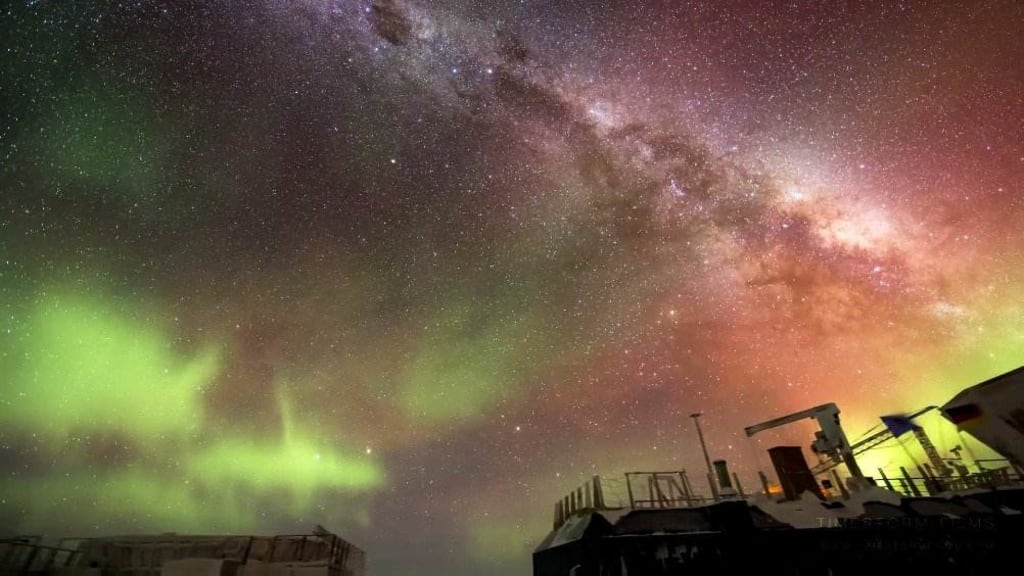
From observations, scientists have tentatively determined that the wall is about 1.37 billion light years long and was only discovered in 2020 because it lies behind the Milky Way galaxy and is obscured.
This wall is located in the southern part of the solar system and is most easily found in the Antarctic region, hence the name "Antarctic Wall".
So what is the South Pole wall, and does it keep us from exploring the universe?
The mysterious South Pole Wall
The South Pole Wall isn't really a wall. It's made up of galaxies, strung together like a wire, forming a structure about 1.4 billion light years in size.
The number of galaxies in the South Pole Wall may exceed 1,000, making it larger than the Ranja Kea supercluster, home to our own Milky Way galaxy.
The Ranja Kaia supercluster is just 520 million light-years across, while the Southern Wall extends more than twice as far.
In terms of location, the South Pole Wall is behind the Ranja Kaia supercluster, about 500 million light years away, and can be interpreted as our giant neighbor.
The supercluster to which the wall belongs has not yet been determined, and some scientists believe that the wall may not be part of a supercluster, but a cosmic web.
It has long been thought that the structure of the universe resembles that of biological cells, particularly nerve cells.
Take human beings for example, the human body has a neural network, spread all over the body, substances can be transmitted in the neural network, such as various neurotransmitters, the brain control the whole body through the neural network.

The same is true of the universe. Superclusters are neurons in the nervous system. They do not exist alone in the universe, but may have special structural connections with neighboring superclusters.
In this way, the whole universe is like a network, called the cosmic web.
The cosmic web is also called the "interstellar highway" by scientists because matter can pass through it.
The South Pole Wall is about a billion light years from our solar system, which isn't too far away in cosmic terms, so scientists think it's important for studying the true structure of the universe.
The hierarchy of structures in the universe
The solar system is already huge for humans, and our Voyager 1 and Voyager 2 spacecraft still haven't reached its outermost layer, the Oort Nebula, after more than 40 years.
However, the solar system is only the smallest level in the system of the universe.
The hierarchy above the solar system is the Milky Way, which has more than 100 billion stars, ranging from UY, which is 4.5 billion times more massive than the Sun, to red dwarfs, which are half the mass of the Sun.
Galaxies come in many shapes. Ours is a barred spiral galaxy, but there are also spiral galaxies, elliptical galaxies and irregular galaxies.
The Milky Way is the name for our galaxy, and for other galaxies, we can call them extragalactic galaxies.
The Milky Way and its 50 or so neighbors make up the Local Group, a small cluster of galaxies that covers only about 10 million light-years.
When the number of galaxies exceeds 100, they are called clusters. The closest cluster to us is the Virgo cluster, which contains more than 2,500 galaxies.

Neither clusters of galaxies nor clusters of galaxies are the highest order of systems in the universe. There is something even bigger above them, called superclusters.
The supercluster we are in is called the local supercluster, also known as the Virgo supercluster because its center is the Virgo cluster.
But even the Virgo supercluster isn't the largest structure. It belongs to a structure called the Ranikayla supercluster, which is the largest supercluster ever found.
By far, the largest system in the universe is the supercluster. Scientists do not deny that there are larger systems beyond the supercluster, but they have not been found due to the current astronomical observation.
The South Pole wall, however, is probably another cosmic structure that is floating away from the supercluster, and it is a link between the different superclusters.
They are connected in a kind of filaments that may be woven together by dark matter.
We need to see more structure to know what the structure of the universe really is, and whether superclusters are independent of each other or interconnected





Comments
There are no comments for this story
Be the first to respond and start the conversation.